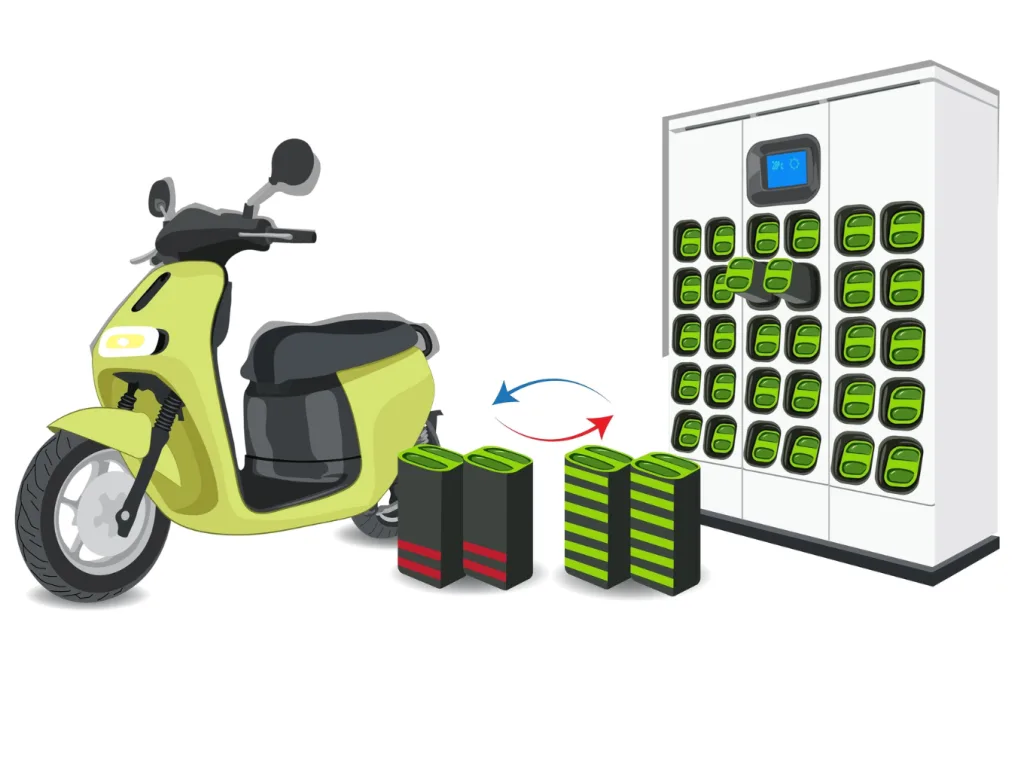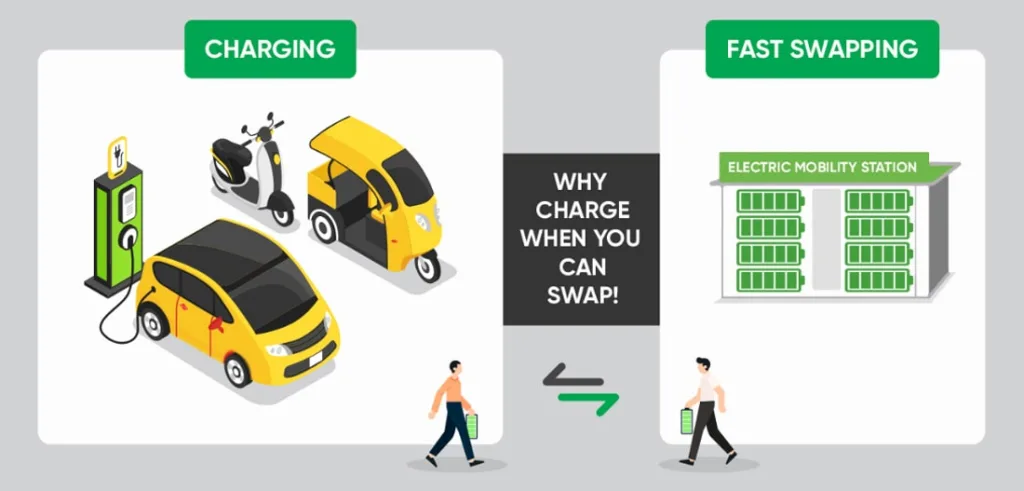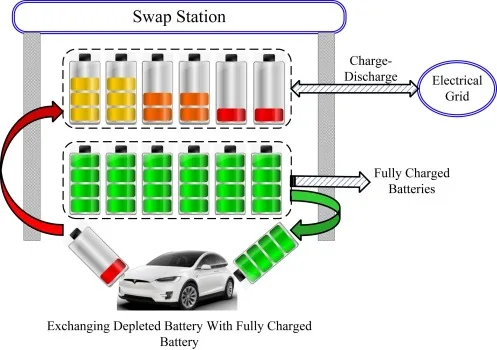The electric vehicle landscape is undergoing a profound transformation, and at the center of this revolution is a technology that’s finally coming into its own: EV battery swapping. After years of false starts and skepticism, battery swapping stations are emerging as a compelling alternative to traditional charging, offering EV owners the promise of “refueling” their vehicles in under five minutes—a game-changing proposition that could finally eliminate range anxiety for good.
“We’re witnessing the perfect convergence of factors that make battery swapping not just viable but potentially transformative,” says Dr. Ellen Chen, Director of Emerging Technologies at the Electric Vehicle Association. “Standardization efforts, improved battery designs, and changing consumer expectations are creating an environment where swapping makes more sense than ever before.”

The Pendulum Swings: From Skepticism to Enthusiasm
Battery swapping isn’t a new concept. In fact, it’s been around almost as long as electric vehicles themselves. Companies like Better Place famously attempted—and ultimately failed—to establish swapping networks in the early 2010s. Even Tesla briefly experimented with the technology before abandoning it in favor of its Supercharger network.
So what’s changed? Why is battery swapping suddenly gaining renewed attention and investment?
The answer lies in a confluence of technological, economic, and market factors that have fundamentally altered the landscape:
| Factor | Past Challenges | Current Advantages |
|---|---|---|
| Battery Standardization | Proprietary designs made cross-compatibility impossible | Growing industry alignment on modular battery formats |
| Infrastructure Costs | Prohibitively expensive to build and maintain stations | Economies of scale and improved designs reducing costs |
| Vehicle Integration | Cars not designed with swapping in mind | Purpose-built EVs with swappable architecture |
| Market Size | Too few EVs to support viable network | Critical mass of electric vehicles on roads |
| Business Models | Reliance on vehicle sales and subscriptions | Focus on energy-as-a-service and fleet operations |
This shift is particularly evident in commercial applications, where predictable routes and centralized operations make battery swapping an increasingly attractive option.
Commercial Fleets: The Perfect Testing Ground
While battery swapping for passenger vehicles continues to face challenges, the commercial sector has emerged as the ideal proving ground for the technology. Companies like Ample, Swobbee, and Nio are finding success by focusing on specific use cases where the advantages of swapping are most pronounced:
- Delivery Vehicles: Last-mile delivery fleets benefit from quick turnaround times and predictable routes.
- Ride-Sharing Services: Maximizing vehicle uptime is critical for profitability.
- Electric Motorcycles and Scooters: Smaller batteries are easier to standardize and swap.
- Taxi Fleets: High-mileage vehicles need rapid refueling solutions.
“For commercial operators, time is literally money,” explains Maria Gonzalez, fleet operations manager at GreenDelivery, which recently converted to a swappable battery system. “Every minute one of our vehicles spends charging is a minute it’s not making deliveries. With battery swapping, we’ve increased our effective fleet capacity by nearly 20% without adding a single vehicle.”
Global Leaders Emerging in Different Markets
The battery swapping landscape varies significantly by region, with different approaches gaining traction in different markets:
China: The Battery Swapping Powerhouse
China has emerged as the global leader in battery swapping infrastructure, with extensive government support driving rapid adoption:
- Nio: The EV manufacturer has built over 2,000 swapping stations and completed more than 40 million battery swaps.
- CATL: The world’s largest battery manufacturer has launched its EVOGO swapping service.
- National Standards: China has established official standards for swappable batteries, facilitating broader adoption.

Europe: Focus on Commercial Applications
European companies are taking a more targeted approach, focusing on specific commercial applications:
- Swobbee: Specializing in light electric vehicles and micromobility swapping stations.
- Ample: Partnering with Uber and other fleet operators for modular swapping solutions.
- PowerSwap: Developing automated swapping technology for passenger vehicles.
India: Leapfrogging Traditional Charging
India, with its unique mobility challenges and energy infrastructure limitations, is embracing battery swapping as a way to accelerate EV adoption:
- Battery Smart: Building a network of swapping stations for electric rickshaws and two-wheelers.
- Sun Mobility: Partnering with vehicle manufacturers to create swappable platforms.
- Government Policy: India has introduced a comprehensive battery swapping policy to encourage standardization and adoption.
The Economics of Swapping vs. Charging
The financial equation for battery swapping is becoming increasingly favorable, particularly as scale increases and technology matures:
| Aspect | Traditional Charging | Battery Swapping |
|---|---|---|
| Refueling Time | 30 minutes to several hours | 3-5 minutes |
| Infrastructure Cost | Lower initial investment | Higher upfront costs, lower scaling costs |
| Battery Ownership | Consumer bears full cost and depreciation | Potential for battery-as-a-service models |
| Grid Impact | High peak demands during popular charging times | Distributed charging of batteries reduces grid stress |
| Vehicle Pricing | Higher upfront cost includes battery | Potentially lower vehicle prices without battery |
| Battery Lifespan | Individual usage patterns affect longevity | Professionally managed batteries with optimized charging |
“The beauty of battery swapping is that it separates the vehicle purchase from the battery,” notes Dr. James Williams, energy economist at the University of California. “This creates flexibility in business models and potentially makes EVs more affordable by removing the most expensive component from the upfront purchase price.”
The Road Ahead: Challenges and Opportunities
Despite the promising developments, battery swapping still faces significant hurdles before it can become a mainstream solution for all electric vehicles:
Standardization Remains the Biggest Challenge
For a truly universal swapping ecosystem to emerge, the industry needs greater standardization of battery form factors, connection interfaces, and communication protocols. Progress is being made, particularly in China where national standards exist, but global alignment remains elusive.
“It’s a classic chicken-and-egg problem,” explains Vikram Patel, CEO of SwapTech Solutions. “Manufacturers won’t commit to standardized designs without a robust swapping infrastructure, and infrastructure developers can’t scale without standardized batteries. Someone needs to break this cycle.”

Consumer Perception and Education
Many EV owners have become accustomed to charging their vehicles at home, enjoying the convenience of starting each day with a full battery. Shifting consumer habits and explaining the benefits of swapping will require significant education and marketing efforts.
“Once you experience the convenience of a three-minute swap compared to even the fastest DC charging, there’s no going back,” says Ling Wei, a regular user of Nio’s battery swapping network in Shanghai. “But getting people to try it the first time requires overcoming skepticism.”
Integration with Renewable Energy
Perhaps the most exciting potential of battery swapping lies in its ability to serve as a flexible energy storage system that can help balance renewable energy generation:
- Grid Balancing: Batteries can be charged when renewable energy is abundant and electricity is cheap.
- Demand Response: Swapping networks can adjust charging patterns based on grid needs.
- Second Life Applications: Batteries that no longer meet the demands of vehicles can be repurposed for stationary storage.
Also Read: Tata Nano EV: The Icon to Return in Electric Form
FAQs About EV Battery Swapping
How does battery swapping work?
Battery swapping involves replacing a depleted EV battery with a fully charged one at specialized stations. The process typically takes 3-5 minutes and is largely automated. The depleted battery is then recharged at the station for use by another vehicle, creating an efficient rotation system.
Is battery swapping available for all electric vehicles?
Currently, battery swapping is limited to vehicles specifically designed for this capability. Companies like Nio have built their vehicles with swappable architecture, while many commercial fleets are adopting purpose-built vehicles. Most mainstream EVs from manufacturers like Tesla, GM, and Volkswagen are not currently compatible with battery swapping systems.
How does the cost of battery swapping compare to traditional charging?
Battery swapping typically operates on a subscription or pay-per-use model. While the per-swap cost may be higher than charging, the value proposition includes significant time savings and potentially lower upfront vehicle costs if the battery is leased rather than purchased. Some models also include unlimited swaps for a monthly fee, similar to a mobile phone data plan.
Where is battery swapping most widely available?
China currently leads in battery swapping infrastructure, with thousands of stations operational. India is rapidly developing its network, particularly for two and three-wheeled vehicles. Europe and North America have more limited deployments, often focused on specific commercial applications rather than general consumer use.
Will battery swapping replace traditional charging?
Most industry experts see battery swapping as complementary to traditional charging rather than a replacement. Home charging will likely remain the primary method for many EV owners, with swapping providing an alternative for long-distance travel, commercial applications, or situations where rapid refueling is essential.
The Future of Mobility: Beyond Charging
As we stand at this inflection point in the evolution of electric vehicles, it’s becoming increasingly clear that battery swapping represents more than just an alternative refueling method—it’s potentially a fundamentally different approach to how we think about energy storage and transportation.
By decoupling the battery from the vehicle, swapping creates new possibilities for business models, grid integration, and consumer accessibility that traditional charging simply cannot match. While challenges remain, particularly around standardization and infrastructure deployment, the momentum behind battery swapping has never been stronger.
For commercial fleet operators, the case is already compelling. For average consumers, the proposition grows more attractive as networks expand and vehicle options increase. And for the electrical grid, the flexibility offered by a distributed network of batteries that can be charged optimally represents a powerful tool for managing the transition to renewable energy.
There has indeed never been a better time for EV battery swapping—and the best may be yet to come.


